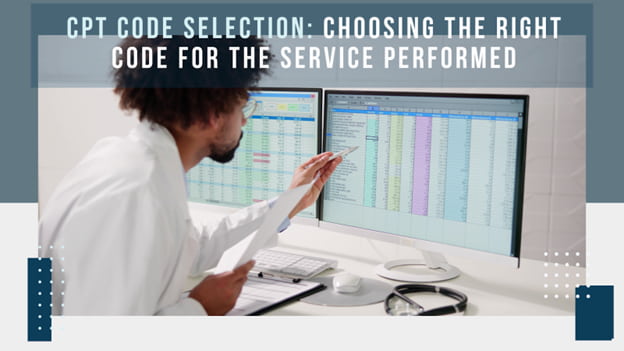In the intricate world of medical billing and insurance claims, accurate CPT code selection is paramount. CPT codes act as a universal language, streamlining communication between healthcare providers, patients, and insurers.
However, navigating the complexities of CPT code selection, which comes with its challenges and potential pitfalls, is crucial.
1. Understanding the Complexity of CPT Code Selection
Selecting the appropriate CPT code is crucial for optimizing reimbursement and minimizing claim denials. The American Medical Association (AMA) emphasizes the importance of a uniform coding language, underscoring the significance of precise code selection. Each CPT Category I code corresponds to a specific procedure or service, making it imperative to choose the correct code to ensure accurate billing and claims processing.
Common pitfalls in CPT code selection include undercoding, overcoding, and misinterpreting the nuances of code descriptions. These errors can lead to financial losses, delayed payments, and potential legal ramifications. Recognizing the complexity of CPT code selection is the first step toward mastering this essential aspect of medical practice management.
2. Strategies for Selecting the Correct CPT Code
To navigate the intricate world of CPT code selection, a structured approach is vital. The CPT code manual is organized into six main sections based on different fields of healthcare, such as Evaluation and Management, Anesthesiology, Surgery, Radiology, Pathology, and Laboratory. Understanding this organization can help narrow down the appropriate code section for the service performed.
Effectively using the CPT code manual is key. Familiarize yourself with the manual’s indexes, appendices, and coding guidelines to ensure accurate code selection. Utilizing CPT code lookup tools and CPT code lookup databases can streamline the process, providing quick access to code descriptions and clarifications.
Detailed and comprehensive medical documentation is essential for supporting CPT code selection. Clear and precise documentation of the services performed, including any specific procedures, diagnoses, or modifiers, lays the foundation for accurate coding. Here are some best practices for documentation:
– Use specific terminology: Avoid vague or ambiguous language when describing procedures or services.
– Include relevant details: Document any unique circumstances, complications, or additional procedures performed.
– Utilize templates or prompts: Leverage documentation tools or templates that prompt for the necessary information required for accurate coding.
– Review and update regularly: Continuously review and update medical records to ensure accuracy and completeness.
– Collaborate with coding professionals: Consult with certified coders or coding experts to ensure proper understanding and application of coding guidelines.
– Participate in coding education: Attend coding seminars, workshops, or webinars to stay up-to-date with coding best practices and changes in guidelines.
By following these strategies, healthcare professionals can streamline the process of CPT code selection, reduce coding errors, and optimize reimbursement for the services provided.
3. Advanced Considerations in CPT Code Selection
Delving deeper into CPT code selection reveals advanced considerations for healthcare professionals. Modifiers play a crucial role in altering the description of services to ensure accurate billing. For example, adding a modifier can indicate a procedure’s increased complexity or a distinct aspect.
Navigating complex scenarios, where multiple CPT codes seem applicable, requires a nuanced understanding of code descriptions and guidelines. In these cases, a detailed review of the service documentation and consultation with coding experts are crucial in determining the most appropriate code.
Staying updated with annual CPT code changes is vital for maintaining billing accuracy and maximizing reimbursement. The AMA releases updates to the CPT code set each year, reflecting changes in medical practices, emerging technologies, and regulatory requirements. Healthcare providers must remain vigilant and adapt their coding practices accordingly to ensure compliance and optimal revenue cycle management.
The AMA’s commitment to keeping the CPT code set current with contemporary medical science and technology is evident in the latest updates for 2024, as highlighted in the following table:
| Category | Change | CPT Codes |
| COVID-19 Immunizations | Consolidation and streamlining of codes | Over 50 previous codes consolidated |
| COVID-19 Monovalent Vaccines | New provisional codes | 91318-91322 |
| COVID-19 Vaccine Administration | New code for any COVID-19 vaccine | 90480 |
| Respiratory Syncytial Virus (RSV) Immunizations | New product-specific codes | 90380, 90381, 90683, 90679, 90678 |
| Evaluation and Management (E/M) Services | Clarifications and revisions | Formatting changes, definition of “substantive portion,” instructions for inpatient/observation care services |
This table showcases the AMA’s rigorous editorial process, which ensures that the CPT code set remains a trusted language for coding and data-driven demands in the ever-evolving healthcare landscape.
4. Leveraging Technology for Accurate CPT Code Selection
Technology has become a powerful ally in CPT code selection within the ever-evolving healthcare landscape. Sophisticated software and tools, including AI-driven solutions, are designed to assist healthcare professionals in identifying the most appropriate CPT codes for the services rendered.
One significant advantage of these technological solutions is their integration with electronic health records (EHR) systems. Seamlessly connecting coding tools with EHR platforms allows healthcare providers to streamline their workflow and enhance CPT code selection accuracy. Real-time access to patient records and coding databases significantly reduces coding errors, optimizing revenue management.
Case studies have demonstrated the efficacy of these technological solutions in reducing coding errors and improving overall financial performance. For instance, a study published in the Journal of Medical Practice Management highlighted a 15% reduction in coding errors and a 10% increase in reimbursement rates after implementing an AI-driven CPT code selection tool.
When evaluating CPT code list and procedure code lookup solutions, consider factors such as ease of integration, customization options, and ongoing support and updates. Investing in robust coding tools can streamline operations and provide a competitive edge in the ever-evolving healthcare industry.
Conclusion
Accurate CPT code selection is a critical component of efficient medical billing and claims processing. By understanding the complexities involved, mastering strategies for code selection, considering advanced factors, and leveraging technological solutions, healthcare professionals can optimize their coding practices and improve financial performance.
Continuous education and adaptation to evolving coding standards and guidelines are essential. Embracing coding tools and AI-driven solutions can streamline workflows, reduce errors, and enhance revenue cycle management, ultimately benefiting both healthcare providers and patients.
Frequently Asked Questions
How do I determine the most appropriate CPT code when multiple codes seem applicable?
When faced with multiple potential CPT codes, it’s essential to review the service documentation meticulously. Scrutinize the details of the procedure performed, any unique circumstances, and the specific terminology used in the code descriptions. If the ambiguity persists, consulting with coding experts or seeking guidance from professional organizations can help ensure accurate code selection.
What are the most common mistakes in CPT code selection, and how can they be avoided?
Frequent coding errors include over-coding (selecting a code that overstates the services provided) and under-coding (selecting a code that understates the services). These mistakes can lead to denied claims, delayed payments, and potential legal consequences. To avoid such errors, healthcare providers should prioritize comprehensive documentation, stay up-to-date with coding guidelines, and leverage available resources, such as coding tools and professional training.
How often do CPT codes change, and how can I stay informed about these changes?
The AMA updates the CPT code set annually, typically in the latter part of the year . These updates accommodate changes in medical practices, emerging technologies, and regulatory requirements. To stay informed, healthcare providers should subscribe to coding newsletters, attend coding seminars or webinars, and regularly review updates from professional organizations and coding authorities.
Did you find this helpful? Check out our other helpful articles on our website.
Read Also
- Creative Approaches to Alleviating Healthcare Staff ShortagesHospitals and clinics are facing staff shortages, which makes it harder to take care of patients well. Finding simple and useful solutions is very important. Easy changes like flexible work hours, good training, and chances to grow can help staff stay happy. Technology, like online doctor visits and helpful tools, can make work easier. Smart… Read more: Creative Approaches to Alleviating Healthcare Staff Shortages
- Understanding the Role of Sterilizers in Healthcare FacilitiesHave you ever wondered how hospitals keep their equipment safe enough to use on dozens of patients every day? Most people never think about what happens behind the scenes, yet these hidden steps play a huge role in patient safety. Sterilizers are part of that system, working quietly to remove harmful germs before any instrument… Read more: Understanding the Role of Sterilizers in Healthcare Facilities
- Building Healthcare Access Where It’s Needed Most: A Local First ApproachHealthcare shouldn’t depend on where you live. But in the U.S., it often does. If you’re in a big city, you likely have options. If you’re in a small town or an underserved neighbourhood, it’s a different story. To fix this, more healthcare leaders are turning to a local-first approach. That means putting clinics and… Read more: Building Healthcare Access Where It’s Needed Most: A Local First Approach
- Revolutionizing Patient Engagement: Innovative Solutions for Improved Care and Treatment SuccessNavigating healthcare system can often feel overwhelming for patients. Between appointments, prescriptions, and treatment regimens, it’s easy for crucial details to get lost in the shuffle. That’s why effective patient engagement and support solutions are more important than ever. Companies like Serva Health, with their pharma hub services, are stepping up to ensure that patients… Read more: Revolutionizing Patient Engagement: Innovative Solutions for Improved Care and Treatment Success
- On-Demand Healthcare Staffing As A Cost-Saving StrategyThis is an exciting and challenging time for the healthcare industry. Technology is advancing almost faster than humans can keep pace. New legislation is creating fresh challenges for the future of healthcare, and the shifting population demographic continues to place more pressure on healthcare facilities. Amidst these changes, healthcare facilities are facing a critical staffing… Read more: On-Demand Healthcare Staffing As A Cost-Saving Strategy
- The Benefits of Contract Labor Staffing in HealthcareThe most successful healthcare facilities today aren’t just reacting to crises—they are building workforce resilience to withstand them. Unpredictable patient demand, coupled with persistent nursing shortages, has made the traditional staffing model obsolete. Relying on mandatory overtime to cover a sudden surge in capacity is a recipe for high turnover and rising employee burnout relief… Read more: The Benefits of Contract Labor Staffing in Healthcare
- Management Reinforcement for Healthcare Providers in a Shifting SystemHealthcare is changing faster than ever. So, providers are feeling the pressure to keep up. New technology, changing patient needs, and constant rule updates make it tough for managers to stay on top. Strong leadership helps teams work better, give great care, and stay happy in their jobs. Here’s how healthcare leaders can strengthen their… Read more: Management Reinforcement for Healthcare Providers in a Shifting System
- Why Effective Disinfection Remains the Foundation of Public HealthFrom hospitals and schools to transport hubs and food production sites, disinfection is central to breaking the chain of infection and protecting community health. The COVID-19 pandemic highlighted how crucial surface hygiene and environmental control are in reducing the spread of harmful microorganisms. Yet, beyond emergency response, routine and validated disinfection practices remain the cornerstone… Read more: Why Effective Disinfection Remains the Foundation of Public Health









